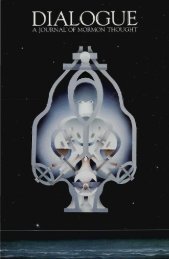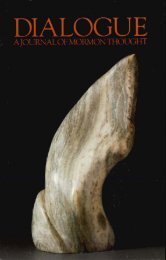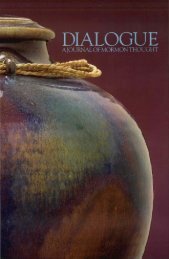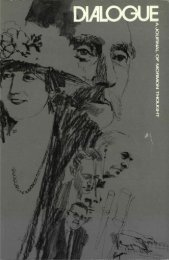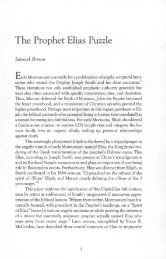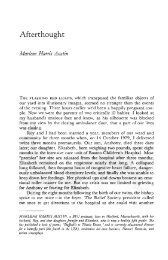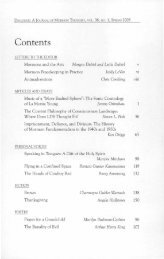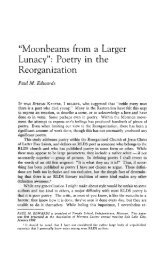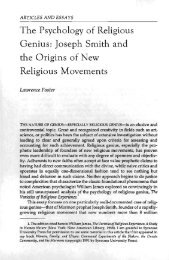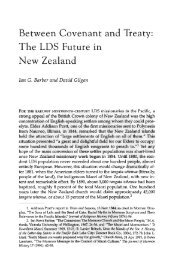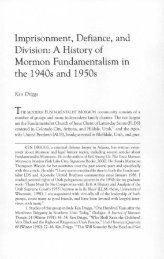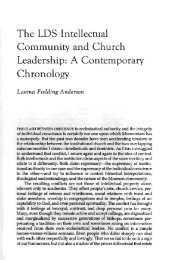Dialogue, Volume 25, Number 2 - Dialogue – A Journal of Mormon ...
Dialogue, Volume 25, Number 2 - Dialogue – A Journal of Mormon ...
Dialogue, Volume 25, Number 2 - Dialogue – A Journal of Mormon ...
Create successful ePaper yourself
Turn your PDF publications into a flip-book with our unique Google optimized e-Paper software.
Lindquist: The Bambara Mirror 59<br />
less dependent than ours on supplies manufactured and purchased in<br />
the market.<br />
We interlopers thus noticed fewer opposites than simple difference<br />
in surface detail between the two cultures. We discovered that our feelings<br />
were ambiguous. We admitted our appreciation for opportunities<br />
at home that Bambara life could not provide, even as we felt a bit <strong>of</strong><br />
guilt for our self-indulgence. But our entry into the Ouelessebougou<br />
villages also resembled, I see in retrospect, what James Clifford has<br />
called an allegorical retreat to the garden (Clifford 1986, 113-14).<br />
Village life seemed a refuge, an Edenic sanctuary from civilization,<br />
a momentary satisfaction <strong>of</strong> nostalgic yearning for something gone,<br />
for life simple and primitive, uncluttered by industrial effluvium,<br />
motors, and material possessions, but replete with communal affection,<br />
innocence, and benevolence. Here we could understand why our<br />
expedition leader's wife said that these people possessed "peace <strong>of</strong> mind,<br />
companionship and a oneness with [themselves]." Women chanting<br />
and cleaning, preparing food in pastoral quiet, colorfully wrapped or<br />
unabashedly bare-breasted, babes on backs or playing peacefully<br />
with older siblings, chickens underfoot and donkeys rummaging, life<br />
natural, classless, outside <strong>of</strong> time —surely this was life lived the way<br />
God had intended.<br />
For we have been taught —here in Western civilization, particularly<br />
in America where the agrarian myth helped blaze the trail across<br />
the continent, opening the frontier and domesticating the land; perhaps<br />
especially here in Utah where we revere pioneer ancestors for making<br />
the desert "blossom like a rose" —we have been taught that people<br />
close to nature's heart, tillers <strong>of</strong> the soil performing the most useful<br />
and necessary <strong>of</strong> labors, are people most integrated, closest to their<br />
authentic selves, to their core, to God.<br />
Perhaps because we desired to adopt some <strong>of</strong> that "authenticity" in<br />
addition to substantiating memory, we Utahns collected evidence —<br />
photos, recordings, Bambara blankets and carvings, all kinds <strong>of</strong> material<br />
images and objects — to certify our presence in this recent Edenic past —<br />
a presence and past both disintegrating as we lived them. Metonyms<br />
<strong>of</strong> something larger, frozen paradigms <strong>of</strong> gestures, feelings, and relationships<br />
too brief, the physical evidence stands for the "something"<br />
we desire; we desire the illusion <strong>of</strong> peace and unity portrayed by and<br />
transmitted through association with a less sophisticated and more pristine<br />
people.<br />
Wanting to capture and hold something so elusive yet so "essential"<br />
as integrity is only human. Yet the very words "capture" and "hold"<br />
indicate a problem. For by photographing the Bambara women at<br />
work and recording their music on tape, by hanging upon Salt Lake



